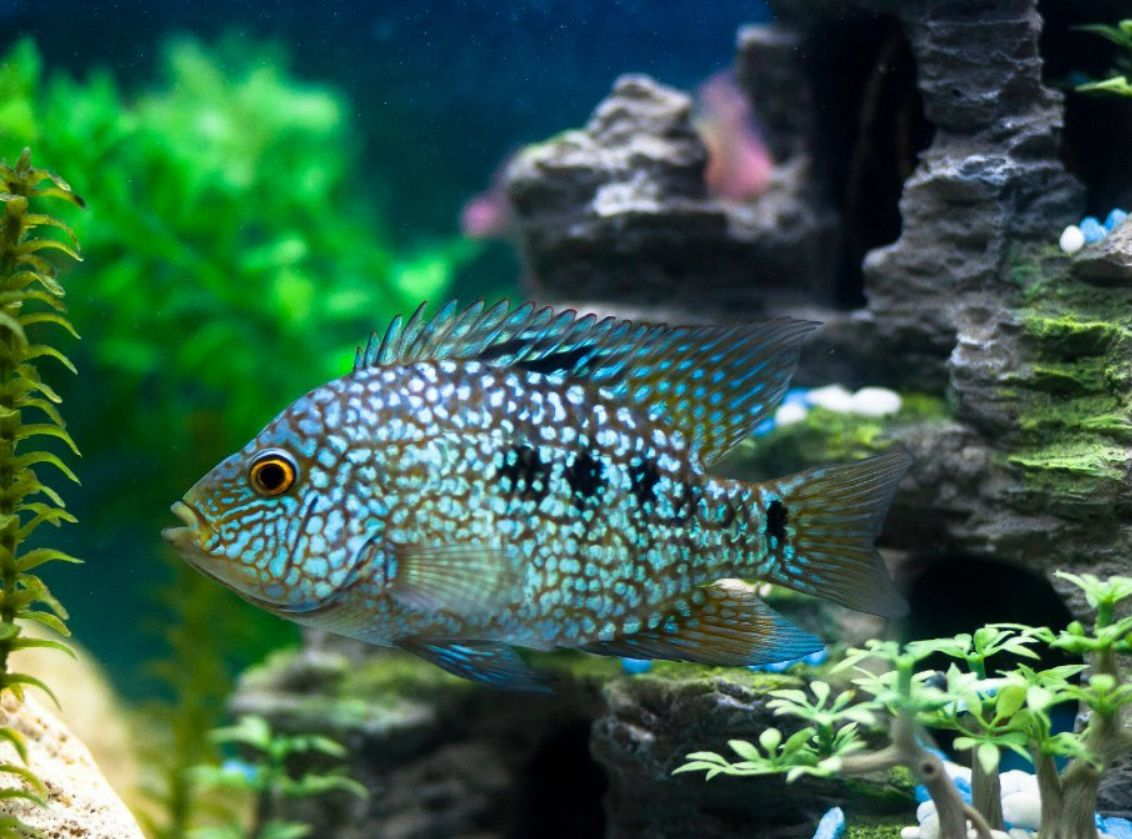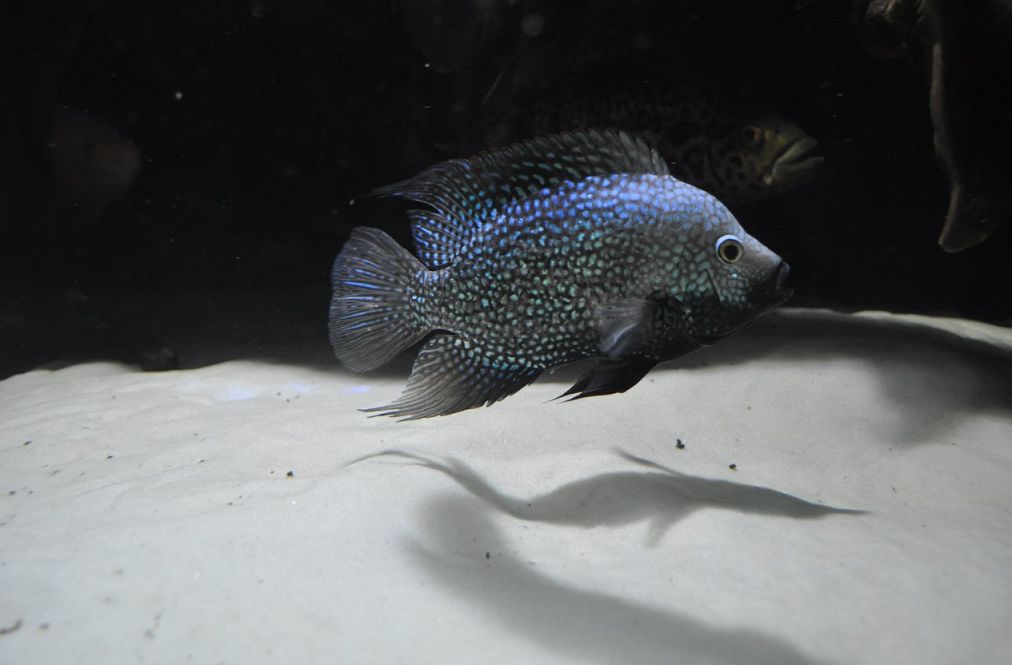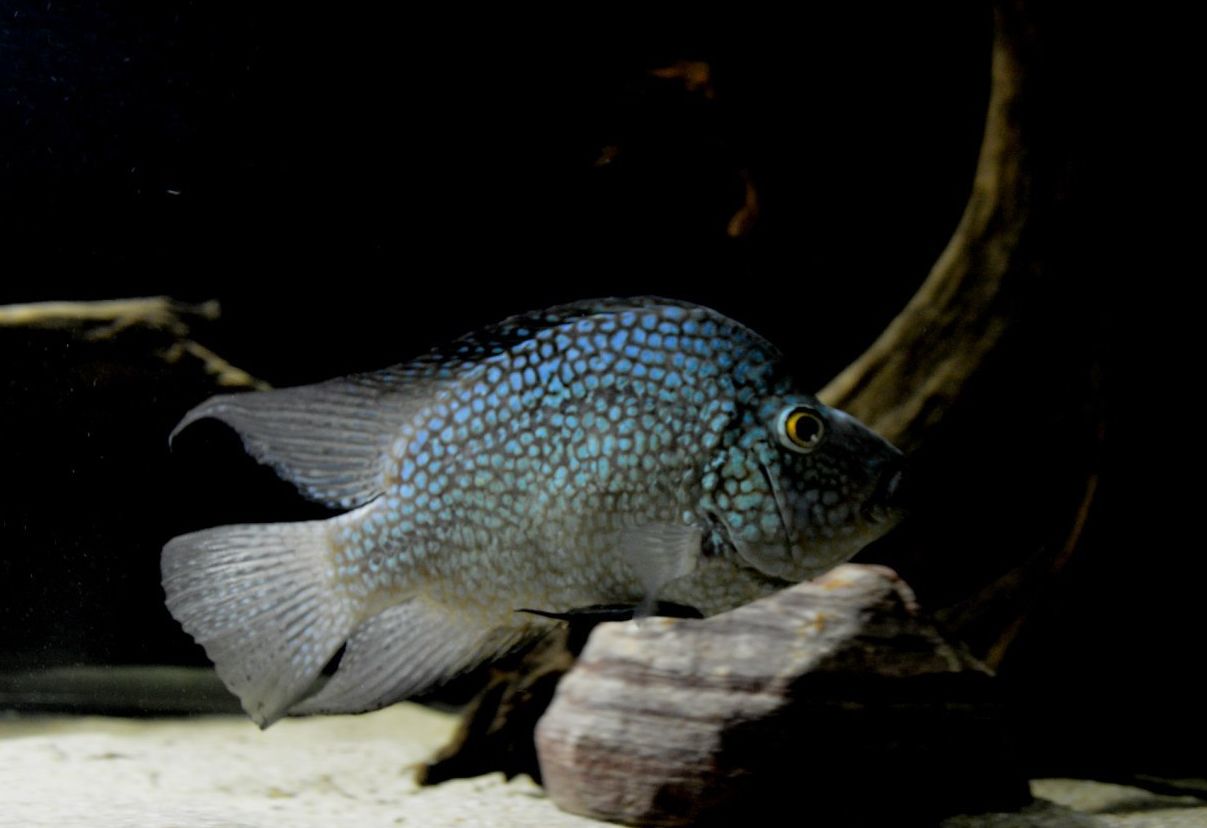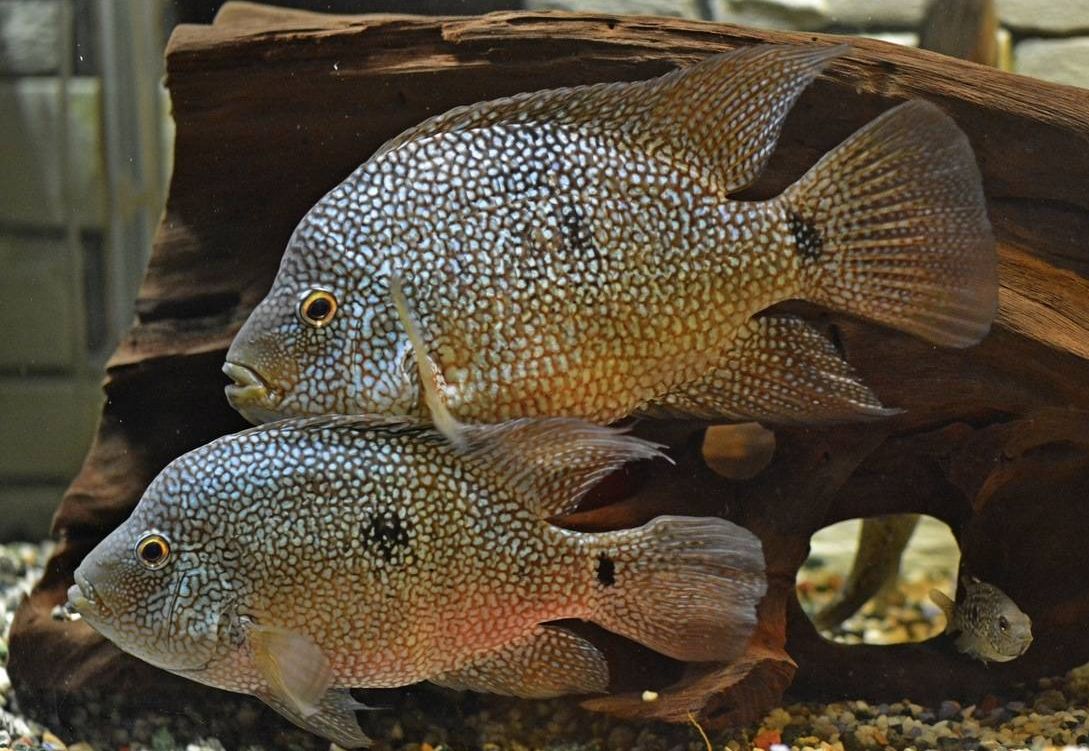The Texas cichlid (Herichthys cyanoguttatus) is a large, good looking and at that rather aggressive fish. In the wild it inhabits in rivers of Texas (for example, Rio Grande, due to which the fish got its name Rio Grande cichlid) and in North Mexico.

Contents
Habitat in the wild
The Texas cichlid, scientifically known as Herichthys cyanoguttatus, belongs to the family Cichlidae. The Cichlidae family is a diverse group of freshwater fish that includes a wide range of species known for their interesting behaviors, vibrant colors, and complex breeding habits. Cichlids are found in various parts of the world, but they are especially diverse and abundant in Africa, Central and South America. They inhabit a variety of freshwater habitats, such as lakes, rivers, and streams.
Texas cichlid natural areal is in North America and North-East of Mexico. This is the only cichlid in the wild that dwells in the USA and at that it wasn’t exported there or naturalized. Nowadays its areal has become wider and except Texas it also dwells in Florida and Louisiana.
This Texas cichlid is encountered both in fast flowing rivers and in lentic waters – in lakes and ponds. It can dwell both in neutral waters and in those with high hardness, at pH values from 7.5 to 9.0 as well as at large temperature alterations. This cichlid can dwell both in warm and cold waters. Thus we can say that the fish is highly adaptive.
High degree of adapting has become the reason that the areal has widened and it is considered to be an invading species, which is gradually pushing out endemic fish species.
Description
Size
It can be up to 30 cm long (20 inches), but the female is a bit smaller than the male. However, in tanks this fish grows smaller in general (about 20 cm long). The size of individual Texas cichlids can vary based on factors such as genetics, diet, water quality, and the size of the aquarium they are kept in.
In the wild, where they have more space and resources, Texas cichlids might have the potential to reach their maximum size. In aquariums, their growth might be slightly limited by the available space and other environmental factors. Providing a spacious tank and proper care can contribute to healthier growth and a better overall quality of life for these fish.
Lifespan
The average lifespan of a Texas cichlid is typically around 10 to 15 years in captivity when provided with proper care. Factors that can influence the lifespan of Texas cichlids include the quality of their environment, diet, water parameters, genetics, and overall health.
Providing a suitable and well-maintained aquarium environment, offering a balanced and nutritious diet, and addressing any health issues promptly can contribute to a longer and healthier lifespan for Texas cichlids in captivity. Regular monitoring and appropriate care practices can help ensure that these fish thrive and live out their full potential lifespan.
Body
Texas cichlid has oval shaped, flattened from sides body with a concave forehead and curved back. The fish has big head and large mouth.
The main color of the body is dark-brown. The stout body of the fish including its head and fins is covered with light-blue and green or olive green large variegated spots. There are several dark transverse stripes on the body sides, though sometimes they aren’t very pronounced or can’t be even seen on some species.
There are several (round as a rule) dark spots that begin from the middle of the body and look like a lateral dash line. However, again these spots sometimes can’t be seen on some species.
Texas cichlid are also famous due to their ability to hybridize with many similar kinds. But this is a problem as well, since under these names both hybrids and completely different fishes are sold.
For example, red Texas cichlid this is a hybrid of the fish with flowerhorn. Green cichlid (in most cases this is Herpthys carpintis species which is very much alike) and blue Texas cichlid (there can be many various fish kinds).
All above mentioned leads to confusion in classification and definition of these fishes, especially taking into account that they can hybridize with other fish kinds. What makes the situation a bit easier, is that all these fishes have quite similar requirements for keeping them in a tank, feeding and breeding.
| Characteristic | Description |
|---|---|
| Scientific Name | Herichthys cyanoguttatus |
| Common Name | Texas Cichlid |
| Family | Cichlidae |
| Origin | Rio Grande drainage in Texas and northeastern Mexico |
| Habitat | Slow-moving or still waters with vegetation and rocky substrates |
| Size | Up to around 12-14 inches (30-35 cm) in length |
| Coloration | Typically olive-green to gray with iridescent blue-green spots and markings |
| Temperament | Can be territorial and aggressive, especially during breeding |
| Diet | Omnivorous, feeding on both plant matter and small aquatic animals |
| Breeding Behavior | Exhibits complex breeding behaviors, including digging pits and caring for fry |
| Lifespan | Typically around 10-15 years in captivity |
| Aquarium Requirements | Large tank with hiding spots, rocks, and plants; water temperature around 72-82°F (22-28°C) |
| Conservation Status | Not evaluated (IUCN Red List) |
| Special Considerations | May not be suitable for community tanks due to aggression; requires proper tank setup for breeding behavior |

Difficulties in keeping
Despite its violent temper, territory dependence and size, Texas cichlid has lots of fans among aquarists. They get seduced by the fact that this is one of the brightest and rich colored cichlids, so they proudly demonstrate the fish in their large species tanks.
It is not difficult to keep Texas cichlid, it is quite undemanding and eats almost everything. However, yet the fish is not for beginners! It may demonstrate aggression towards its tank mates and can turn any nice and decorated tank into ruins.
Besides, it also produces a lot of organic waste and as a result requires a strong filter as well as frequent water renews.
Keeping in a aquarium
These cichlids require large tanks with quality filtration, but they are comparatively easy to keep. This is a right fish for those aquarists who want to keep large American cichlids in their tank.
Tank size
The tank size required for Texas cichlids can vary based on several factors, including the number of fish, their size, and their behavior. Generally, Texas cichlids can become quite large and are known for their territorial and sometimes aggressive nature, especially during breeding.
For a single Texas cichlid, a tank size of at least 75 to 100 gallons (284 to 379 liters) is recommended. This provides enough space for the fish to swim comfortably and establish their territories. If you plan to keep a pair or a small group of Texas cichlids, you should consider a larger tank to accommodate their territorial behaviors. A tank with dimensions of around 6 feet (1.8 meters) in length, 2 feet (0.6 meters) in width, and 2 feet (0.6 meters) in height could work well for a pair or a small group.
Of course, lots of aquarists keep the fish in far smaller tanks and then they wonder why their fish don’t grow as large as ones that their friends have. The thing is that large fish requires a large tank, otherwise it won’t reach its maximum size.
Creating hiding spots, using rocks and decorations to establish territories, and providing ample swimming space are important considerations when setting up an aquarium for Texas cichlids. Regular water maintenance and monitoring are also essential for their well-being.
Remember that providing enough space and a suitable environment can help reduce stress and aggression among Texas cichlids, leading to healthier and more vibrant fish.
Water parameters
The Texas cichlid is rather undemanding in terms of tank water parameters. Here are the recommended water parameters for Texas cichlids:
- Temperature: 72-82°F (22-28°C)
Texas cichlids prefer a water temperature within this range. Keeping the temperature consistent and within their preferred range helps prevent stress and disease. - pH Level: 6.5-8.0
Texas cichlids can tolerate a relatively wide pH range, but keeping it within this range is generally suitable. Avoid rapid pH fluctuations, as they can stress the fish. - Hardness (GH and KH): Moderate to Hard
Texas cichlids come from areas with naturally higher mineral content, so a moderate to hard water hardness (GH and KH) is usually preferable. Aim for a GH around 8-12 dGH and a KH around 6-10 dKH. - Ammonia, Nitrite, and Nitrate:
Keep ammonia and nitrite levels at zero, as these are toxic to fish. Nitrate levels should be kept as low as possible, ideally below 20-30 ppm through regular water changes and proper filtration. - Filtration and Water Quality:
Efficient filtration is essential to maintain water quality. Texas cichlids can be messy eaters and produce waste, so a good filtration system, regular water changes, and proper maintenance are important to prevent ammonia and nitrite buildup.
Remember that it’s important to acclimate Texas cichlids slowly to any changes in water parameters. Sudden shifts can stress the fish and lead to health problems. Regular water testing and observation of the fish’s behavior can help you maintain the best possible water conditions for their well-being.
Tank decor
Besides that the fish leaves lots of organic waste after feeding, it also likes digging tank bottom substrate. Therefore put a thick layer of the substrate. The type of bottom substrate isn’t that crucial issue, but it’s better be sand or small gravels. Still most of tank plants won’t be able to grow in this tank – they will be either eaten or dug out by the fish.
Texas cichlids don’t fight much as long as they have enough of shelters and place to swim in the tank. Land form of the tank should consist of small gravels or sand as well as of snags and stones.
We can’t recommend putting some tank plants into the bottom substrate, since they are most likely to be torn off, because the fish digs the substrate all the time. But still you can take a chance and put more enduring kinds of tank plants such as anubias nana.

Diet
The Texas cichlid is an omnivorous one. It’ll eagerly eat artificial food. Special high quality pellets for cichlids can be the basic component of the diet, but you have to diversify it with frozen and live food components. You can feed it with live fish, but there is a risk to bring infection into the tank.
Don’t forget to give the fish food with high vegetable content or with spirulina. Fish flesh, prawns and mussels are good supplements to the diet. Try not to feed the fish with mammal flesh, for example, with ox heart since it is too fat.
Don’t feed the Texas cichlid too much to avoid tank water contamination. You can feed the adult species once a day.
Tank mates
Texas cichlid isn’t the best choice for a community tank and it’s desirable to keep it in a roomy tank alone or a couple of them. Of course, everything depends on the tank conditions, tank capacity and even on the temper. Just like many large cichlids of Central and North America, cichlid can be very territory dependent especially during its spawning period and sometimes it gets very aggressive. It will treat any small fishes as food.
Their behavior is quite changeable and as a rule they are moderately aggressive. The fish is perfect to keep with other cichlids of the same size (or larger), that still may show some aggression or put a couple of fish in a species tank.
Though the fish behavior to a great extent depends on its temper, thus some aquarists say that their pets get along well with other species, though in some cases the situation is completely different.
So, yet any large cichlids can be possible tank mates for Texas cichlid (though, this is in the lap of the gods), large sized catfishes (like sailfin pleco or common pleco).
There are some reports as for successful keeping with black ghost knifefish, maybe this fish isn’t taken as a fish by cichlid and that’s why it doesn’t pay attention to it.
Gender differences: male vs female
Distinguishing between male and female Texas cichlids can be a bit challenging, especially when they are young. However, as they mature, there are some general differences that you can observe to help differentiate between males and females. Keep in mind that individual variations and other factors can influence these characteristics.
Here are some typical differences between male and female Texas cichlids:
Male Texas Cichlid:
- Size: Males tend to be slightly larger and more robust than females, especially as they mature.
- Coloration: Adult male Texas cichlids often exhibit more vibrant and intense colors, especially during the breeding season. They might have brighter blues and more prominent spots on their bodies.
- Nuchal Hump: Some mature males develop a nuchal hump on their forehead, which is a characteristic bump that can become more pronounced during breeding.
- Fin Extensions: Males may have slightly longer and more pointed dorsal and anal fins compared to females.
- Behavior: During the breeding season, males become more territorial and aggressive, displaying behaviors to attract females and defend their territory.
Female Texas Cichlid:
- Size: Females are generally slightly smaller and more streamlined than males.
- Coloration: Female Texas cichlids tend to have duller and less intense coloration compared to males. Their spots and markings might be less vibrant.
- Nuchal Hump: Females typically lack the nuchal hump that is often seen in mature males.
- Fin Shape: Females may have slightly rounder and shorter dorsal and anal fins compared to males.
- Behavior: Females can also exhibit territorial behavior, especially during the breeding season, but their behaviors are different from those of males.
It’s important to note that these differences might not be very noticeable until the fish reach maturity, which can take a year or more. If you’re specifically interested in sexing your Texas cichlids, observing their behavior during the breeding season and paying attention to physical differences, such as coloration and fin shape, can help you make an educated guess about their gender.

Texas cichlid breeding
Quite often it is hard to create a ‘harmonious’ couple. The best way to get it is to buy a group of 6 and more young fish and let them grow together. This way they will form the couple themselves. When it finally happens, the courtship period starts, the fish start ‘flirting’ with each other – they swing around each other snapping the partner’s body side with a tail.
If they like each other and form a couple, both fish will change their body coloring to almost black (hind body of the fish) and its forepart becomes light (almost white). The area for spawning will be cleaned by the fish. Usually this is a small smooth area of stone. A fixed inclined plane will do perfectly for this purpose. Sometimes the female digs a pit and uses it as a nest.
The Texas cichlid female starts laying eggs and then the male fertilizes it. Both parents will fan the eggs with their abdominal fins to saturate the water near them with oxygen. The only problem during the fish spawning is that the male may become aggressive towards the female, therefore you should have kind of division fence just in case.
The egg stage lasts up to for 2 days, than the larvae hatches (at this stage they can be moved into some other places that their parents prepared in advance) and a week later the juveniles start to swim.
It’s not difficult to grow the juveniles, if you provide them with sufficient amount of food. Brine shrimp nauplii can be start food for the juveniles. As they grow make the food size larger and proceed to more diversified diet.